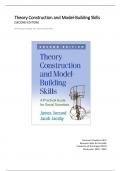Samenvatting
Summary (CH 4 & 5) Theory Construction and Model-Building Skills, Second Edition - Research skills Pre-MSc (EBB101A05)
- Instelling
- Rijksuniversiteit Groningen (RuG)
Summary of Chapters 4 and 5 of Theory Construction and Model-Building Skills, Second Edition - Research skills Pre-MSc (EBB101A05). I made this summary for the exam of Research skills Pre-MSc (University of Groningen) because I couldn't find a summary for this chapters myself. I hope my summar...
[Meer zien]





